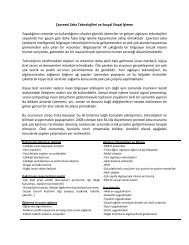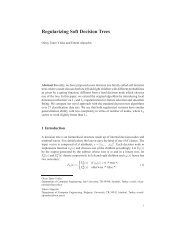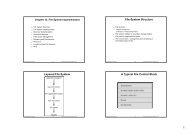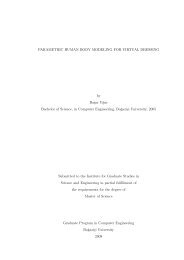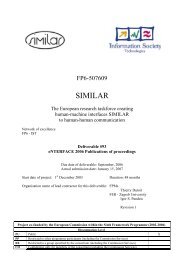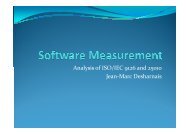CmpE 343 Problem Session 2 Solutions
CmpE 343 Problem Session 2 Solutions
CmpE 343 Problem Session 2 Solutions
You also want an ePaper? Increase the reach of your titles
YUMPU automatically turns print PDFs into web optimized ePapers that Google loves.
<strong>CmpE</strong> <strong>343</strong> <strong>Problem</strong> <strong>Session</strong> 2 <strong>Solutions</strong><br />
1 Question 1<br />
October 20, 2010<br />
There are k different coins (C1, C2, . . . , Ck) in a box. The probability of Heads<br />
when flipping Ci is 1/i for 1 ≤ i ≤ k. A coin is selected from the box randomly,<br />
and gets tossed until a Head appears.<br />
(a) Write down a probability space for the experiment. Be sure to verify<br />
that the sum of the probabilities of the sample points is 1.<br />
(b) What is the probability that a Head is first seen in the second toss?<br />
(c) Given that a Head is first seen in the second toss, what is the probability<br />
that Ci was the coin selected from the box?<br />
(d) Check your answer to part (c) to be sure it satisfies<br />
P r(C1|H2) + P r(C2|H2) + . . . + P r(Ck|H2) = 1<br />
where H2 is the event of seeing the first Head on trial 2.<br />
(e) Assume that P r(k = i) = 1/10 for i = 1 to 10. Find the joint probability<br />
P r(Hk, k), where Hk is the event of seeing the first Head on trial k.<br />
1.1 Solution<br />
(a) {C1, C2, . . . , Ck}x{H, T H, T T H, T T T H, . . . , T n H, . . .}<br />
P r(Ci, T n H) = 1 1 1<br />
(1 −<br />
k i i )n<br />
k� ∞�<br />
P r(Ci, T n k� ∞� 1 1 1<br />
H) =<br />
(1 −<br />
k i i )n<br />
i=1 n=0<br />
=<br />
= 1<br />
1<br />
i=1 n=0<br />
k�<br />
i=1<br />
1 1<br />
k i<br />
∞�<br />
(1 − 1<br />
n=0<br />
i )n
(b)<br />
P r(T H) =<br />
k�<br />
P r(T H|Ci)P r(Ci)<br />
i=1<br />
= 1<br />
k<br />
k�<br />
i=1<br />
1 1<br />
(1 −<br />
i i )<br />
These are the famous Riemann Zeta functions. No solution is known yet.<br />
(c)<br />
(d)<br />
(e)<br />
2 Question 2<br />
P r(Ci|T H) = P r(T H|Ci)P r(Ci)<br />
P r(T H)<br />
=<br />
i−1<br />
i 2<br />
� k<br />
j=1<br />
k�<br />
P r(Ci|T H) =<br />
i=1<br />
= 1<br />
k�<br />
i=1<br />
j−1<br />
j 2<br />
i−1<br />
i 2<br />
� k<br />
j=1<br />
j−1<br />
j 2<br />
P r(Hk, k) = P r(T k−1 H|k)P r(k)<br />
k�<br />
= P r(T k−1 H, Ci|k)P r(k)<br />
=<br />
i=1<br />
k�<br />
P r(T k−1 H|Ci, k)P r(Ci|k)P r(k)<br />
i=1<br />
= 1 1<br />
10 k<br />
k�<br />
i=1<br />
1 1<br />
(1 −<br />
i i )k−1<br />
In an imaginary TV show, the contestant is required to select and open one of<br />
three boxes. The grand prize is inside one of the boxes, and the contestant gets<br />
nothing, if one of the wrong boxes is selected. First, the contestant selects a box.<br />
Then, the anchorman opens an empty box, selected from the remaining boxes.<br />
Finally, the contestant is asked again, if she wants to change her selection. For<br />
instance, the contestant selects the box A. The anchorman opens the box B<br />
and reveals that it’s empty. Then, the contestant either continues with her first<br />
selection A, or decides to choose C instead. What is the probability of getting<br />
2
the grand prize, if she changes her selection? (Hint: To get an intuition, imagine<br />
the same scenario with 100 boxes, so that when you select a box, 98 empty boxes<br />
are revealed.)<br />
2.1 Solution<br />
The event of opening one of the remaining boxes which is empty has a probability<br />
of 1, meaning that it is always possible to do so. Therefore, this does not affect<br />
the prior probability of selecting the correct box in the first try, which is 1/3.<br />
This means that the probability of the grand prize being in one of the remaining<br />
boxes is still 2/3, and the anchorman kindly showed which box to select, if the<br />
grand prize is indeed in one of the remaining boxes. So, the contestant should<br />
change her box, which doubles her chance of finding the grand prize.<br />
Imagine trying to draw the ace of spades from a full deck of cards. The<br />
probability that you find it is 1/52. Now, someone comes and opens 50 more<br />
cards, none of which is the ace of spades. This does not change the fact that<br />
when you picked your card, you picked it from a full deck, so your chance does<br />
not change. However, the remaining closed card now has the entire probability<br />
mass of the opened cards, which is 51/52.<br />
3 Question 3<br />
The joint probability density function of the random variables X, Y and Z is<br />
�<br />
2 4xyz<br />
f(x, y, z) =<br />
0<br />
0 < x, y < 1; 0 < z < 3<br />
elsewhere<br />
(1)<br />
Find<br />
(a) the joint marginal density function of Y and Z,<br />
(b) the marginal density of Y,<br />
(c) P (1/4 < X < 1/2, Y > 1/3, 1 < Z < 2),<br />
(d) P (0 < X < 1/2|Y = 1/4, Z = 2).<br />
3.1 Solution<br />
(a)<br />
� 1<br />
f(y, z) =<br />
0<br />
4xyz2 dx<br />
9<br />
= 2x2yz2 |<br />
9<br />
1 x=0<br />
= 2yz2<br />
9<br />
3
(b)<br />
(c)<br />
f(y) =<br />
� 3<br />
0<br />
2yz 2<br />
9 dz<br />
= 2yz3<br />
27 |3 z=0<br />
= 2y<br />
P (1/4 < X < 1/2, Y > 1/3, 1 < Z < 2) =<br />
� 1/2 � 1 � 2<br />
1/4<br />
= 7/162<br />
1/3<br />
(d) Note that x,y,z independent. So, P (x|y, z) = P (x).<br />
P (0 < X < 1/2|Y = 1/4, Z = 2) = P (0 < X < 1/2)<br />
=<br />
� 1/2<br />
0<br />
= 1/4<br />
1<br />
2xdx<br />
Here, f(x) is directly taken as 2xdue to its symmetry with y.<br />
4 Question 4<br />
The probability density function of an exponential distribution is<br />
�<br />
−λx λe x ≥ 0, λ > 0<br />
f(x) =<br />
0 x < 0<br />
4xyz2 dzdydx<br />
9<br />
Show that<br />
P r(T > s + t|T > s) = P r(T > t), s, t > 0<br />
where random variable T is exponentially distributed. Explain why this<br />
property is called the memorylessness property.<br />
4.1 Solution<br />
� ∞<br />
P r(T > k) = λe −λx dx<br />
k<br />
= −e −λx | ∞ k<br />
= e −λk<br />
4<br />
(2)
P r(T > s + t ∩ T > s)<br />
P r(T > s + t|T > s) =<br />
P r(T > s)<br />
= P r(T > s + t)<br />
P r(T > s)<br />
= e−λs+t<br />
e −λs<br />
= e −λt<br />
= P r(T > t)<br />
So, the past, or the fact that (say) an s amount of time has already passed,<br />
does not change the future. Hence the name, memorylessness.<br />
5



